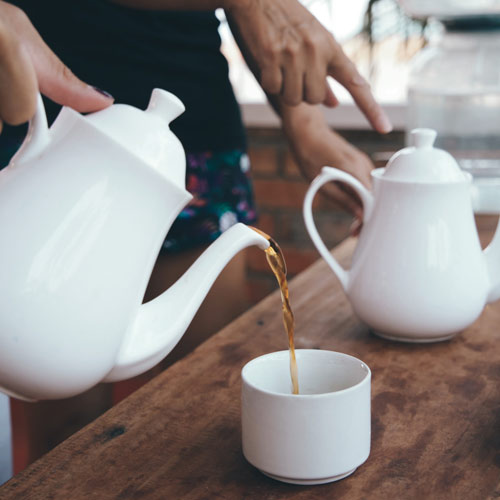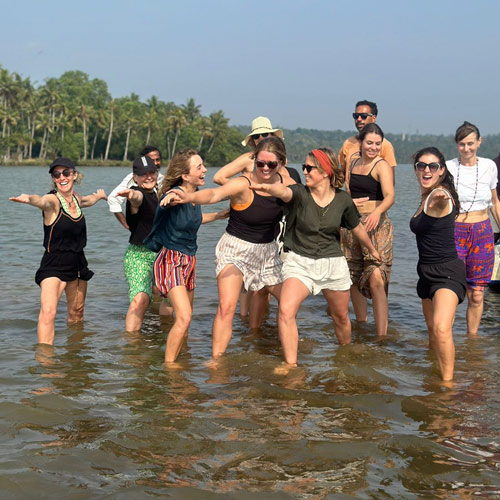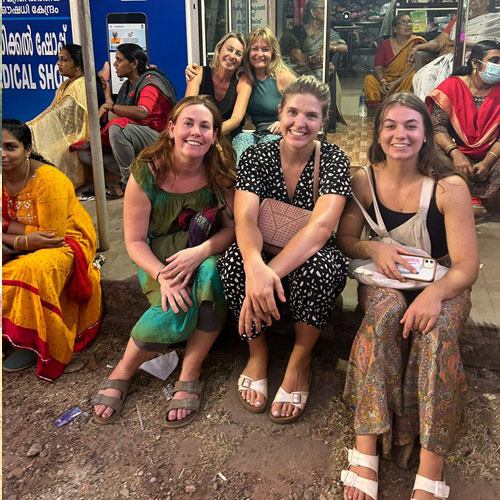Surya Namaskar is 12 yoga asana sequence that are performed in a flow. It is also referred to as Sun Salutations and is a practice that improves your energy levels, flexibility as well as mental stability. The importance of surya namaskar in your life is due to its impact on your overall well being.
These asanas can be performed as a warm-up routine or as a complete workout. Regular practice of just a few rounds of surya namaskar will keep you energetic all the time, boost metabolism, promote inner-peace, and relieve you from the various stressors of the world.
History and Significance of Surya Namaskar

Surya Namaskar originated in India as a way to worship the sun. It has now transcended borders to spread its wisdom across the world. The sun is a powerful source of energy and practicing sun salutations will help you to channelize your energy properly into your body.
The origin of surya namaskar is from the time of ancient rishis and saints, who knew that different divine impulses govern different parts of our body. It has a central point which is called Solar Plexus and is referred to as the second brain of our body. This point is located behind the naval and is believed to be connected to the sun’s energy. Performing surya namaskar on a regular basis will improve the functioning of these solar plexus that will ultimately enhance your creative as well as intuitive powers.
How to Practice Surya Namaskar
Surya Namaskar is an essential practice that will enhance your overall wellness and elevate your lifestyle. The ideal time to practice the 12 poses of sun salutations is during early mornings or sunrise time frame, with an empty stomach. If you are a beginner take proper guidance from an expert in order to understand the correct alignment of the poses and the benefits of them.
Start your surya namaskar journey with 4 to 5 rounds and gradually increase the rounds when the body gets habitual of it. Make sure that you pay attention to synchronized breathing while performing surya namaskar as proper inhale-exhale is an essential step for these 12 movements. Always practice sun salutations in a calm and undisturbed environment so that you can focus on your movements and calm your mind thoroughly.
Also Read – 12 Best Yoga Poses for Two People: Couple Yoga Poses
12 Poses of Surya Namaskar- Names and Benefits
Pranamasana (Prayer Pose)

Pranamasana is also referred to as the Anjali Mudra. It is the first pose of surya namaskar and is a gesture shown as a respect. This pose is a common greeting sign in India and is quite similar to Namaste.
How to do it-
Stand erect and bring your feet closer together. Expand your chest by inhaling and exhaling deeply and relax your shoulders and arms. Raise your arms while inhaling and join both your palms together between your chest.
Benefits-
- It reduces the symptoms of stress, anxiety, and frequent burnouts.
- Helps in relaxing the nervous system
- Maintains the balance of your body
Hasta Uttanasana (Raised Arm Pose)

“Hasta” refers to the hand and “Uttanasana” refers to stretching in the upward direction. This yoga asana signifies that you are reaching out to the universe and welcoming the energy which the sun is providing you.
How to do it-
Stretch your arms in the upward direction while inhaling and make sure to keep your biceps closer to your ears. Avoid any excessive strain on your lower back and try to engage your core. You need to push your pelvis a little bit in the forward direction.
Benefits-
- It tones the muscles of your abdomen and improves digestion
- This asana also helps in easing the pain or excessive stress in your lower back
- It stimulates the nervous system and stretches the body completely from head to toe
Padahastasana (Hand to Foot pose)
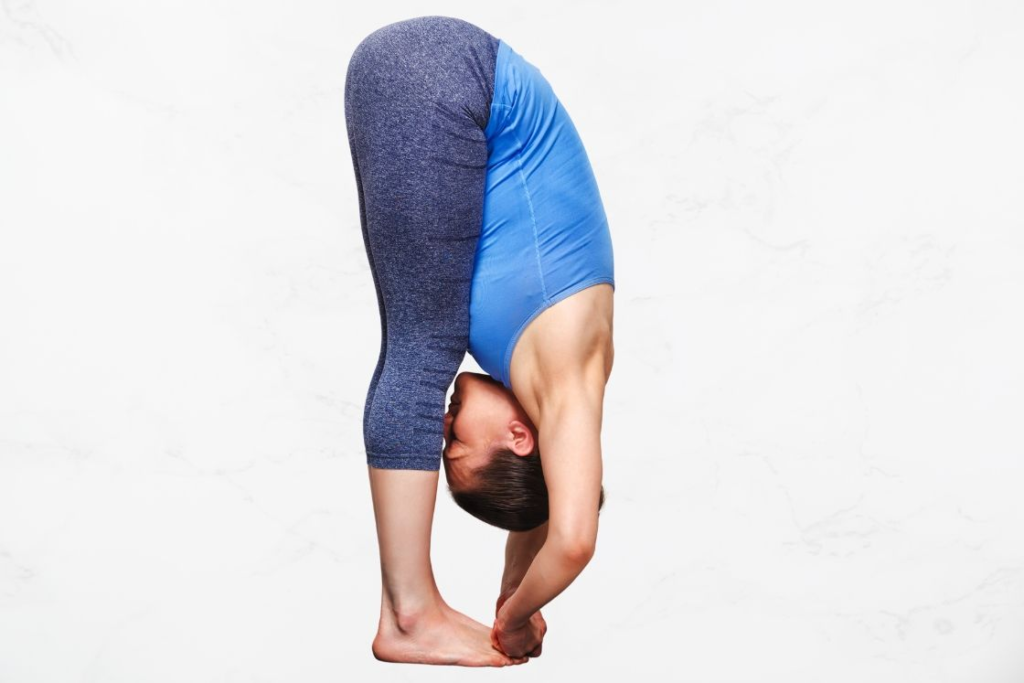
This yoga asana signifies surrendering and supporting humility in both mind as well as body. Here, “pada” means legs/feet and “hasta” means hand.
How to do it-
Bend forward from your hip area while exhaling. Touch your toes while keeping your knees straight. You can also place both your palms on the floor besides your feet. Make sure that your spine and knees are not bending. Evenly balance out your body’s weight by keeping your shoulders relaxed and gently pressing your heels
Benefits-
- Helps in getting relief from insomnia and osteoporosis
- Reduces the symptoms of burnouts and anxiety
- Relieves you from migraine and frequent headache
- Improves the strength in your legs, especially hamstrings and thighs
- Regulates proper blood circulation and enhances flexibility
Ashwa Sanchalanasana (Equestrian Pose)
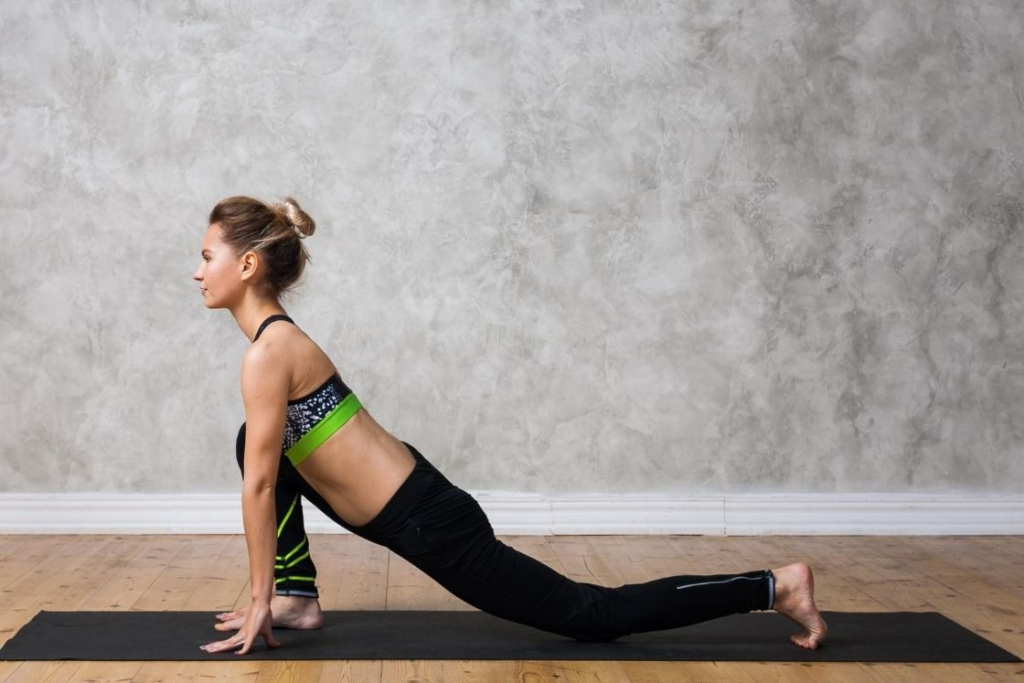
Ashwa Sanchalanasana is the fourth pose of sun salutation and signifies strength and stamina just like a horse. “Ashwa” means horse and “Sanchalan” means movement, so this pose is about moving your body with the stamina of a horse.
How to do it-
Put your right leg backward along with inhaling and lower your knee to the floor. Put you left leg forward, lift your chest and look in the upward direction. Engage and adjust your thighs so that you balance your weight evenly
Benefits-
- This asana opens up your hip flexors
- Improves lung capacity
- Boosts up your digestion system
- Enhances spinal flexibility
- Improves concentration and calms your mind
Also Read – Butterfly Pose in Yoga: How Does It Help in Improving Your Health?
Dandasana (Stick Pose)
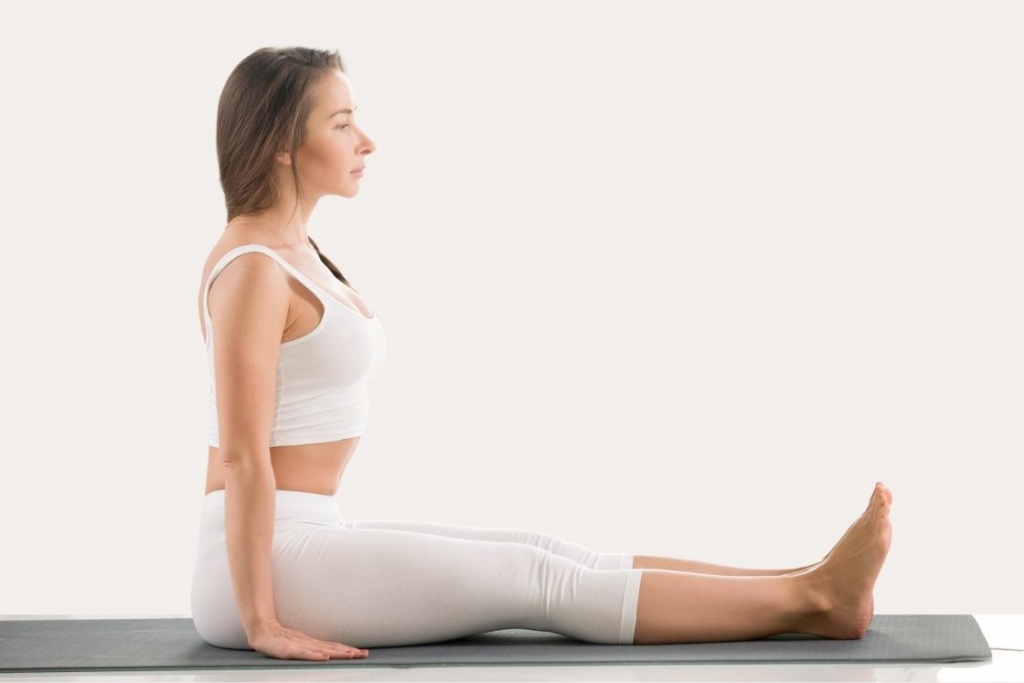
The stick pose represents discipline, stability, and steady nature like a stick. Dandasana is the fifth pose of surya namaskar and should be practiced while focusing on the correct alignment of the body.
How to do it-
Along with exhaling put your left leg back in the pose of a plank. Make sure that your elbows, shoulders, and wrist are at a ninety degree angle against the floor. Keep your body in a straight line, engage your core, and widen your collar bones. Ensure that your neck is relaxed and aligned with your spine.
Benefits-
- This asana will strengthen your arms and build endurance in your body.
- Improves stability and overall balance
- Helps you to calm down and improve posture
Ashtanga Namaskar (Eight-Limbed Pose)

Ashtanga means eight limbs and signifies your body’s full devotion with the help of eight points of contact. It is a unique asana to concentrate on your mind, body, and soul. Ashtanga namaskar in surya namaskar is a great yoga pose to prepare your body for the entire day.
How to do it-
Exhale and put your knees down onto the floor. Rest your chin on the floor along with lifting your hip area a little. Make sure that your chin, hands, chest, and knees are touching the floor and your posterior is held in the air.
Benefits-
- This asana increases flexibility in your spine.
- Strengthens your arms, shoulder, legs, and core.
- Relieves the stress from your neck, spine, and shoulder.
- Stimulates the digestive system and helps in treating constipation.
- Activates the energy chakras in your body and improves posture
Bhujangasana (Cobra Pose)

Bhujanga means cobra in Sanskrit. The asana signifies transformation and rising above the challenges to do better just how a cobra lifts up its hood. This is the seventh yoga pose in surya namaskar and is ideal for people dealing with back aches and cramps.
How to do it-
Raise your head and backbend while inhaling. Keep your palms in the resting position on the mat and ensure that your elbows are bent slightly. Roll your shoulders in the backward direction and keep your neck relaxed. Keep your torso and legs resting on the floor
Benefits-
- Stretches your torso and increases its strength
- Tones the abdominal muscles and relieves back pain
- Eases the symptoms of asthma and improves blood circulation
- Helpful during the menstrual cycle in reducing the cramps
Adho Mukha Svanasana (Downward facing Dog Pose)
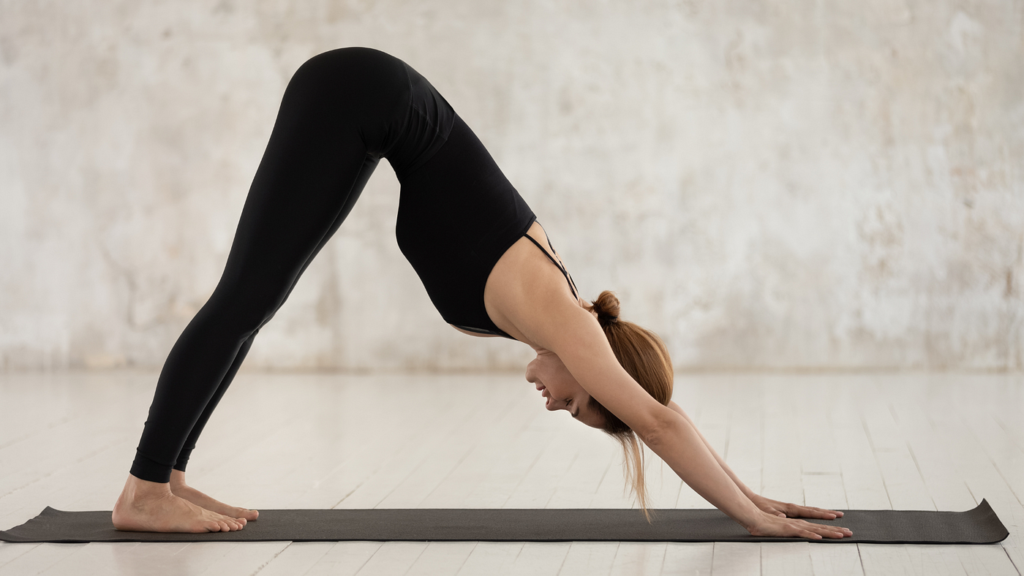
Adho Mukha Svanasana refers to internal grounding and complete rejuvenation. It is a calming yoga asana that has numerous benefits for the human body. It is the eighth asana of the surya namaskar and is performed mainly to calm down the nervous system.
How to do it-
Exhale and lift your hips in the upward direction. Push down your heels on the floor or on the mat. Drop down your head and look towards your naval. Make sure that your body weight is evenly balanced in your limbs. Keep your shoulders and neck relaxed and stretch as much as you can while looking in the downward direction.
Benefits-
- Reduces the cause of stress and anxiety
- Improves blood circulation and calms nervous system
- Relieves menopause symptoms and frequent headaches
Ashwa Sanchalanasana (Equestrian Pose with Opposite leg)

Now from here, the asanas are going to repeat. After coming back from adho mukha svanasana, you will position yourself in Ashwa Sanchalanasana but with the opposite foot.
How to do it-
While coming back from adho mukha svanasana, put your right leg in the forward direction. Keep your left leg behind and slowly look forward. Push your lower back area towards the mat and deepen the stretch.
Benefits-
- This asana opens up your hip flexors
- Improves lung capacity
- Boosts up your digestion system
- Enhances spinal flexibility
- Improves concentration and calms your mind
Hasta Padasana (Hand to Foot Pose)
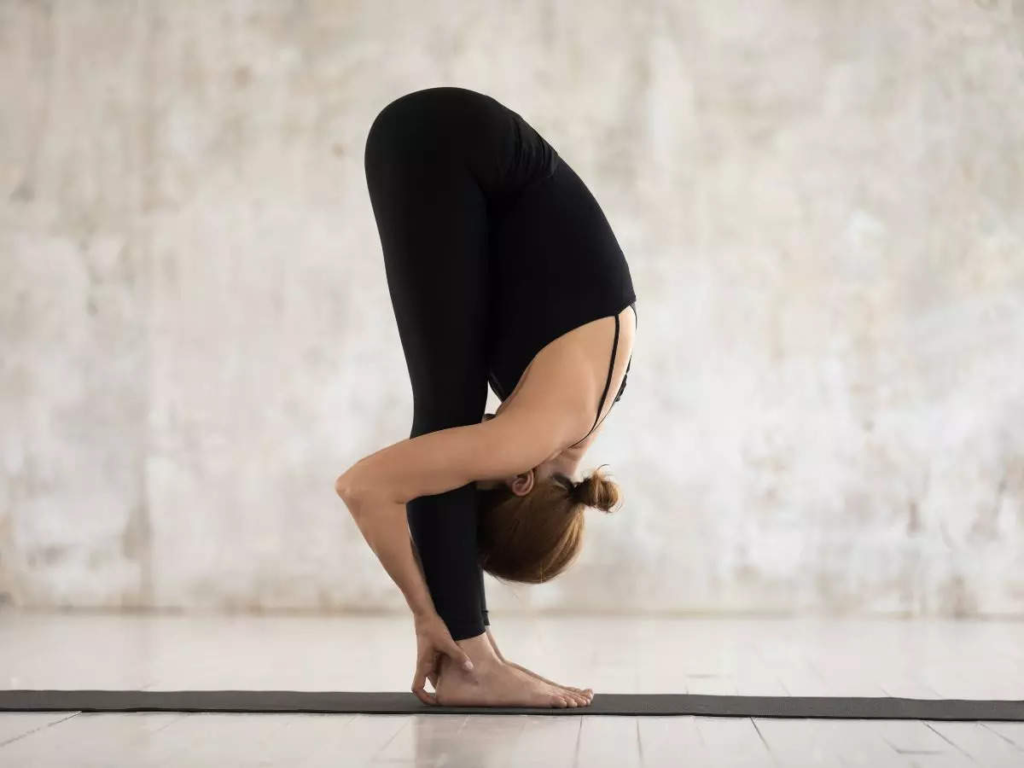
After positioning yourself in Ashwa Sanchalanasana, you will now come back to hasta Padasana. Always remember to inhale and exhale correctly according to the different asanas.
How to do it-
Come back from Equestrian pose to Hasta Padasana, while exhaling. Bring your left foot in the forward direction. Bend your hips in order to touch your toes and keep your knees straight.
Benefits-
- Helps in getting relief from insomnia and osteoporosis
- Reduces the symptoms of burnouts and anxiety
- Relieves you from migraine and frequent headache
- Improves the strength in your legs, especially hamstrings and thighs
- Regulates proper blood circulation and enhances flexibility
Hasta Uttanasana (Returned Raised Arm Pose)

Once again comes in Hasta Uttanasana, which is an essential pose of the sun salutation sequence. It is one of the best asanas to stretch your hamstrings and spine, and strengthen your shoulder as well as arms muscles.
How to do it-
Along with inhaling, raise your arms above and stretch backwards. Look at the ceiling while you are bending backwards. Keep your core engaged.
Benefits-
- It tones the muscles of your abdomen and improves digestion
- This asana also helps in easing the pain or excessive stress in your lower back
- It stimulates the nervous system and stretches the body completely from head to toe
Pranamasana (Return Prayer Pose)

The last pose of the sun salutation sequence is the same as the first pose. Coming back to Pranamasana, exhale and relax yourself. This is the simplest yoga asana of the sequence and can be performed by anyone.
How to do it-
From above, bring both your arms back to the center of your chest. Stand in an upright position and relax your body. Notice that you have completed the first round of 12 poses in surya namaskar.
Benefits-
- It reduces the symptoms of stress, anxiety, and frequent burnouts.
- Helps in relaxing the nervous system
- Maintains the balance of your body
Overall Benefits of Surya Namaskar
Sun salutation has 12 yoga poses in it, which makes it a whole body workout .
- It maintains the health of every organ and tissue in your body, especially heart, lungs, liver, intestines, and kidneys.
- Improves muscle endurance and its stretching abilities.
- Enhances blood circulation and builds overall strength.
- Elevates your posture and flexibility along with reducing the risk of spinal injuries.
- Activates the energy chakras and builds immunity.
- Promotes weight loss and tones the lower body.
- Improves the capacity of your lungs and respiratory functions
- Helps you in stabilizing your mind and calms down the nervous system
Tips for Practicing Surya Namaskar
Here are some important tips you must follow in order to perform all the poses of surya namaskar properly.
- For the best results, practice the rounds of sun salutations on an empty stomach.
- Always listen to your body. If you feel pain or uneasiness with any pose, either skip it or modify it accordingly.
- Start with 3-4 rounds and gradually increase based on how your body reacts.
- Always maintain a normal breathing pattern for every pose.
- Practice in a quiet environment to calm your mind and focus without distractions.
- Pay attention to your alignment in order to prevent serious injuries.
By practicing Surya Namaskar on a regular basis you can learn the holistic approach to overall wellness. It is an age-old yoga practice that improves your physical, mental, as well as emotional health. The 12 poses of sun salutation acts as a connecting bridge between physical movements and mindful meditation.
